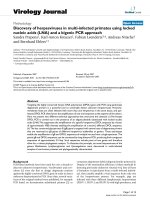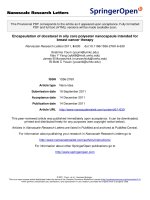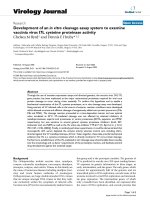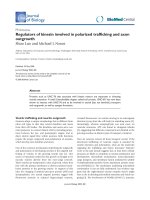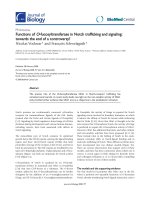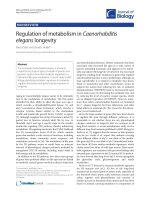Báo cáo sinh học: "volution of virulence in malaria" pps
Bạn đang xem bản rút gọn của tài liệu. Xem và tải ngay bản đầy đủ của tài liệu tại đây (139.63 KB, 4 trang )
Minireview
EEvvoolluuttiioonn ooff vviirruulleennccee iinn mmaallaarriiaa
Bridget Penman and Sunetra Gupta
Address: Department of Zoology, University of Oxford, South Parks Road, Oxford, OX1 3PS, UK.
Correspondence: Sunetra Gupta. Email:
Plasmodium falciparum malaria is responsible for over 1
million deaths each year, mostly in children under the age
of 5 living in sub-Saharan Africa. And yet the number of
malaria infections which go on to become life threatening
is proportionally very small, as the majority of these
infections either remain asymptomatic (due to the
acquisition of clinical but non-sterile immunity after
repeated exposure) or progress to disease without lethal
complications [1]. Viewed in an evolutionary context, the
existence of severe disease presents a population-level
compromise for the parasite between the necessity of
bearing factors that increase survival and transmission and
the risk that these will stimulate a host immune response
that will either curtail the infection or perversely cause the
death of the host (thus also spelling the end for the
parasite). With the aim of identifying factors that may be
relevant in the evolution of this balance, Long et al. in a
recent article in BMC Evolutionary Biology [2] have
investigated the influence of the inflammatory response
on the severity of disease in a rodent model of malaria,
and we discuss here how their results may bear on the
coevolution of parasite and host, in the context of what is
known about the determinants of severe malarial disease
in humans.
FFaaccttoorrss iinn tthhee sseevveerriittyy ooff mmaallaarriiaa
Severe malaria can be resolved broadly into two different
syndromes: cerebral malaria and severe malarial anemia.
Cerebral malaria is associated with impaired
consciousness and sometimes convulsions and coma, and
can leave those who recover with long-term neurological
problems. Its pathophysiology is not fully understood but
it is probably due to a combination of the obstruction of
cerebral capillaries by parasitized cells and an overactive
inflammatory response. Severe malarial anemia occurs
when the suppression of erythrocyte production,
combined with the destruction of red blood cells by the
parasite itself, leads to a particularly profound anemia -
which can cause shock and respiratory distress. Both
syndromes can involve a range of metabolic complications
such as acidosis or hypoglycemia [3].
Both host and parasite factors are likely to contribute to
the processes leading to severe disease, and Long et al.
have examined one possible interaction using mice
infected with different clones of the rodent malaria
parasite Plasmodium chabaudi chabaudi. Specifically, they
have shown that blockade of the receptor for the anti-
inflammatory cytokine interleukin-10 (IL-10) has a
AAbbssttrraacctt
The pathogenesis of severe malarial disease is not yet fully understood. It is clear that host
immunopathology plays a central role, and a recent paper in
BMC Evolutionary Biology
suggests that the ability of the parasite to stimulate interleukin-10 production is a major factor
and speculates on its impact on the coevolution of host and parasite.
Journal of Biology
2008,
77::
22
Published: 28 August 2008
Journal of Biology
2008,
77::
22 (doi:10.1186/jbiol83)
The electronic version of this article is the complete one and can be
found online at />© 2008 BioMed Central Ltd
dramatic impact on time to death of the infected animal,
particularly where the infecting parasite clones are normally
avirulent. This result certainly implies that IL-10 plays a
fundamental role in controlling the inflammatory response
to malaria and that its absence can contribute to the demise
of the murine host; Long et al. propose that the ability of the
parasite to stimulate IL-10 production is a factor
determining its relative virulence. However, whether
regulation of the inflammatory response by IL-10 actually
plays a part in the evolution of parasite virulence remains
an open question and requires a careful consideration of the
population-level consequences of interactions between host
susceptibility and parasite virulence factors.
IInnfflluueennccee ooff hhoosstt ffaaccttoorrss
The best-known host factors affecting the severity of malaria
are genetic disorders of hemoglobin such as the sickle-cell
trait and alpha-thalassemia. Sickle-cell trait offers protection
against both clinical and severe malaria, but the protective
effect of alpha-thalassemia seems to be specific to severe
malaria, particularly severe malarial anemia [4]. The high
frequencies of these genetic disorders seen in malarious
regions testify to their significance in modulating the
outcome of malarial infection, and the advantage they
provide to the host; however, there is little evidence that
they have had any impact on the evolution of parasite
virulence. This is probably because the mechanisms of
protection do not act on any variable features of the
parasite. The presence of sickle hemoglobin seems to affect
several membrane features of a parasitized erythrocyte [5,6]
that may alter the likelihood that an infected cell will be
phagocytosed, and alter the surface properties that allow the
parasite to adhere to blood vessel endothelium, thereby
avoiding phagocytosis by host macrophages and blocking
the vessels. Alpha-thalassemia is associated with micro-
cytosis and a high erythrocyte count, and it has been
suggested that this may protect against extreme hemoglobin
loss during malarial infection [7]. None of these putative
mechanisms would act differentially between parasite
genotypes, and they therefore cannot be expected to drive
the evolution of virulence.
What sort of host factors can we then expect to influence the
evolution of parasite virulence? Obvious candidates are the
host receptors that allow adherence to endothelial cells by
infected erythrocytes - a process that is thought to be funda-
mental to malaria pathogenesis. Polymorphisms in the
endothelial adhesion receptors CD36 and ICAM-1 have
been described in malarious areas; however, case control
studies have so far given conflicting results as to whether
particular alleles do in fact offer protection (reviewed in
[8]). The parasite mediator of cytoadherence is Plasmodium
falciparum erythrocyte membrane protein 1 (PfEMP1),
encoded by the var gene family, and there is evidence to
suggest that the expression of particular subsets of var genes
may be associated with different disease outcomes (Figure 1
and reviewed in [9]). Such variation is likely to be due to
differences in the host receptor binding specificity of the
PfEMP1 encoded by different var genes. It is well established,
for example, that var2csa is associated with binding to the
placenta in pregnancy-associated malaria [9], and a recent
study was able to show a correlation between PfEMP1
amino-acid motifs and severe disease phenotypes [10].
Whether these variations reflect the evolution of the parasite
population to optimize the survival of both parasite and
host remains, however, an open question.
BBaallaanncciinngg hhoosstt aanndd ppaarraassiittee ffaaccttoorrss
As highlighted by Long et al. [2], the cytokines of the innate
immune response play an extremely significant role in both
22.2
Journal of Biology
2008, Volume 7, Article 22 Penman and Gupta />Journal of Biology
2008,
77::
22
FFiigguurree 11
Differential binding of the
P. falciparum
erythrocyte membrane protein
(PfEMP1) to host tissues. The parasite protein PfEMP1 is expressed on
the surface of infected red blood cells and binds to adhesion proteins
chiefly on endothelial cells. Different variants of PfEMP1 bind to
adhesion proteins expressed on different endothelia and lead to
different disease phenotypes. CR1, ICAM-1, CSA and CD36 are all
distinct cellular adhesion molecules. The figure is Figure U11-1.2 from
the online update to
Immunity: The Immune Response in Infectious and
Inflammatory Disease
by DeFranco, Locksley and Robertson (New
Science Press, London, 2007) [18].
ICAM-1 CSA CD36CR1
Infected red blood cells
Uninfected
red blood
cell, platelets
Cerebral
microvascular
endothelium
Placental
microvascular
endothelium
Tissue
microvascular
endothelium
Low birth weight
prematurity
death of fetus
Cerebral malaria
metabolic acidosis
high mortality
Mild
malaria
PfEMP1
the prevention and the exacerbation of severe disease.
There is ample evidence that higher levels of
inflammatory cytokines, such as tumor necrosis factor
(TNF) are associated with a higher likelihood of fatal
cerebral malaria [1,8,11]. Various TNF polymorphisms
have been associated with differing susceptibilities to
severe malaria (reviewed in [8]). Other cytokines, such
as IL-1 and lymphotoxin, have also been implicated [1];
indeed, recent evidence from mice (see [11] and
references therein) suggests that lymphotoxin is more
fundamental to murine cerebral malaria than is TNF.
The findings of Long et al. [2] implicate IL-10 in the
prevention of severe disease, and indeed the possibility
that IL-10 polymorphisms might affect the severity of
malaria has been investigated, although with
conflicting results [8]. If the ability of the parasite to
stimulate IL-10 production is a determinant of its
virulence, as Long et al. suggest, the parasite population
might be expected to coevolve with the host towards an
optimum at which the level of IL-10 production is
sufficient to prevent immunopathology but does not
hamper the control of parasitemia through
inflammatory processes. Much further work is required
to validate such a hypothesis, but it does rightly draw
attention to the fine balance that is required between
the various arms of the innate immune response to P.
falciparum in order to achieve a perfect outcome for the
parasite.
A further glimpse into the complexities of the immuno-
logical processes contributing to severe malaria is
provided by migration inhibitory factor (MIF). This
pro-inflammatory cytokine was thought to be involved
in the pathogenesis of severe malarial anemia, for it
appeared to suppress erythropoiesis in mice [12]; but
subsequent studies in humans suffering from malarial
anemia have found a negative correlation between MIF
level and severity of anemia [13]. Also, a recent study of
MIF levels in Gabonese children with differing histories
of malaria showed that those children who had only
experienced mild malaria tended to have higher MIF
levels than those who had only experienced severe
malaria [14].
Interestingly, there exists MIF homologs in the genomes
of a number of human parasites, including P.
falciparum, and it has been demonstrated that
falciparum-derived MIF (PfMIF) is present in the sera of
malaria patients [15]. That same study also showed that
PfMIF has chemotactic effects on human monocytes, at
lower concentrations than human MIF. This clearly
raises the possibility that parasite-derived factors could
act directly to modulate the host immune response and
set up a coevolutionary process.
OOtthheerr iinntteerraaccttiinngg ffaaccttoorrss iinn ppaarraassiittee vviirruulleennccee
To fully understand the evolution of parasite virulence,
it must be recognized that the selection pressures
imposed on the parasite population by protective factors
within the host are likely to change with time, and may
even be affected in unpredictable ways by interactions
between different host traits. For example, recent work
has demonstrated that the two malaria-protective
genetic disorders of hemoglobin mentioned earlier
(sickle-cell trait and alpha-thalassemia) may interact to
cancel out the malaria protection that either affords
individually [16].
Finally, the potential for host factors to drive evolution
of virulence must be considered in the context of the
development of acquired immunity. The initial inflam-
matory response to the parasite is part of the innate
immune response, which provides immediate defence
against infection. Acquired immunity develops with a
delay and provides long-term protection. There is ample
evidence of a positive role for the immune response in
protecting against severe disease [1,8,17]. The primary
selective force on the parasite population is thus as
likely to be from the protective immune response as
from incidental immunopathology. An interesting
model that includes both of these selective forces has
been proposed in [11]. It is based on the hypothesis that
certain forms of severe malaria result from an excessive
T-cell-mediated inflammatory response. Exposure to the
malaria parasite (or to an antigenically cross-reacting
pathogen) ‘primes’ naive T cells to recognize it in future,
and secondary infection activates those primed cells to
release pro-inflammatory cytokines, causing excessive
and potentially damaging inflammation. Upon
subsequent infections, the various factors contributing
to the development of clinical immunity mean that the
parasitemia tends to be lower - so providing reduced
antigenic stimulation for the primed T cells. In addition,
as part of the development of clinical immunity, the
predominant T-cell phenotype may switch from Th1
cells (producing pro-inflammatory cytokines) to
regulatory T cells (producing anti-inflammatory
cytokines). Severe malaria thus occurs in a window of
incompletely acquired immunity, where the host
immune system responds overzealously to a pathogen it
recognizes, without the means to effectively control the
inflammation. This hypothetical framework could
explain why in malaria-endemic regions, those most at
risk of severe malarial disease appear to be young
/>Journal of Biology
2008, Volume 7, Article 22 Penman and Gupta 22.3
Journal of Biology
2008,
77::
22
children (who have had some previous exposure to the
malaria antigen but who have yet to develop clinical
immunity), but for those who visit malarious regions
from other areas the risk of severe disease increases with
age. The latter could be because it is possible for T cells
to be primed to recognize the malaria parasite by
exposure to a cross-reacting antigen - the chances of
which will increase with age. It is entirely consistent with
this model that the probability of severe disease could be
reduced among individuals who have better ways of
regulating inflammatory processes, thus providing a
route by which factors such as IL-10 may affect the
severity of disease by modulating the actions of the
acquired immune response.
RReeffeerreenncceess
1. Langhorne J, Ndungu FM, Sponaas AM, Marsh K:
IImmmmuunniittyy ttoo
mmaallaarriiaa:: mmoorree qquueessttiioonnss tthhaann aannsswweerrss
Nat Immunol
2008,
99::
725-732.
2. Long GH, Chan BH, Allen JE, Read AF, Graham AL:
EExxppeerriimmeennttaall
mmaanniippuullaattiioonn ooff iimmmmuunnee mmeeddiiaatteedd ddiisseeaassee aanndd iittss ffiittnneessss ccoossttss ffoorr
rrooddeenntt mmaallaarriiaa ppaarraassiitteess
BMC Evol Biol
2008,
88::
128.
3. Mackintosh CL, Beeson JG, Marsh K:
CClliinniiccaall ffeeaattuurreess aanndd ppaatthhoo
ggeenneessiiss ooff sseevveerree mmaallaarriiaa
Trends Parasitol
2004,
2200::
597-603.
4. Williams TN:
RReedd bblloooodd cceellll ddeeffeeccttss aanndd mmaallaarriiaa
Mol Biochem
Parasitol
2006,
114499::
121-127.
5. Ayi K, Turrini F, Piga A, Arese P:
EEnnhhaanncceedd pphhaaggooccyyttoossiiss ooff rriinngg
ppaarraassiittiizzeedd mmuuttaanntt eerryytthhrrooccyytteess:: aa ccoommmmoonn mmeecchhaanniissmm tthhaatt mmaayy
e
exxppllaaiinn pprrootteeccttiioonn aaggaaiinnsstt ffaallcciippaarruumm mmaallaarriiaa iinn ssiicckkllee ttrraaiitt aanndd
bbeettaa tthhaallaasssseemmiiaa ttrraaiitt
Blood
2004,
110044::
3364-3371.
6. Cholera R, Brittain NJ, Gillrie MR, Lopera-Mesa TM, Diakité SAS,
Arie T, Krause MA, Guindo A, Tubman A, Fujioka H, Diallo DA,
Doumbo OK, Ho M, Wellems TE, Fairhurst RM:
IImmppaaiirreedd
ccyyttooaaddhheerreennccee ooff
PPllaassmmooddiiuumm ffaallcciippaarruumm
iinnffeecctteedd eerryytthhrrooccyytteess
ccoonnttaaiinniinngg ssiicckkllee hheemmoogglloobbiinn
Proc Natl Acad Sci USA
2008,
110055::
991-996.
7. Fowkes FJI, Allen SJ, Allen A, Alpers MP, Weatherall DJ, Day KP:
IInnccrreeaasseedd mmiiccrrooeerryytthhrrooccyyttee ccoouunntt iinn hhoommoozzyyggoouuss αα++ tthhaallaassssaaeemmiiaa
ccoonnttrriibbuutteess ttoo pprrootteeccttiioonn aagga
aiinnsstt sseevveerree mmaallaarriiaall aannaaeemmiiaa
PLoS
Med
2008,
55::
e56.
8. Kwiatkowski DP:
HHooww mmaallaarriiaa hhaass aaffffeecctteedd tthhee hhuummaann ggeennoommee
aanndd wwhhaatt hhuummaann ggeenneettiiccss ccaann tteeaacchh uuss aabboouutt mmaallaarriiaa
Am J Hum
Genet
2005,
7777::
171-192.
9. Kyes SA, Kraemer SM, Smith JD:
AAnnttiiggeenniicc vvaarriiaattiioonn iinn
PPllaassmmooddiiuumm
ffaallcciippaarruumm
:: ggeennee oorrggaanniizzaattiioonn aanndd rreegguullaattiioonn ooff tthhee
vvaarr
mmuullttiiggeennee
ffaammiillyy
Eukaryot Cell
2007,
66::
1511-1520.
10. Normark J, Nilsson D, Ribacke U, Winter G, Moll K, Wheelock CE,
Bayarugaba J, Kironde F, Egwang TG, Chen Q, Andersson B,
Wahlgren M:
PPffEEMMPP11 DDBBLL11aallpphhaa aammiinnoo aacciidd mmoottiiffss iinn sseevveerree ddiisseeaassee
ssttaatteess ooff
PPllaassmmooddiiuumm ffaallcciippaarruumm
mmaallaarriiaa
Proc Natl Acad Sci USA
2007,
110044::
15835-15840.
11. Artavanis-Tsakonas K, Tongren JE, Riley EM:
TThhee wwaarr bbeettwweeeenn
tthhee mmaallaarriiaa ppaarraassiittee aanndd tthhee iimmmmuunnee ssyysstteemm:: iimmmmuunniittyy,,
iimmmmuunnoorreegguullaattiioonn aanndd i
immmmuunnooppaatthhoollooggyy
Clin Exp Immunol
2003,
113333::
145-152.
12. McDevitt MA, Xie J, Shanmugasundaram G, Griffith J, Liu A,
McDonald C, Thuma P, Gordeuk VR, Metz CN, Mitchell R, Keefer
J, David J, Leng L, Bucala R:
AA ccrriittiiccaall rroollee ffoorr tthhee hhoosstt mmeeddiiaattoorr
mmaaccrroopphhaaggee mmiiggrraattiioonn iinnhhiibbiittoorryy ffaaccttoorr iinn tthhee ppaatthhoogge
enneessiiss ooff
mmaallaarriiaall aanneemmiiaa
J Exp Med
2006,
220033::
1185-1196.
13. Awandare GA, Ouma Y, Ouma C, Were T, Otieno R, Keller CC,
Davenport GC, Hittner JB, Vulule J, Ferrell R, Ong’echa JM,
Perkins DJ:
RRoollee ooff mmoonnooccyyttee aaccqquuiirreedd hheemmoozzooiinn iinn ssuupppprreessssiioonn
ooff mmaaccrroopphhaaggee mmiiggrraattiioonn iinnhhiibbiittoorryy ffaaccttoor
r iinn cchhiillddrreenn wwiitthh sseevveerree
mmaallaarriiaall aanneemmiiaa
Infect Immun
2007,
7755::
201-210.
14. Awandare GA, Kremsner PG, Hittner JB, Keller CC, Clark IA,
Weinberg JB, Perkins DJ:
HHiigghheerr pprroodduuccttiioonn ooff ppeerriipphheerraall bblloooodd
mmaaccrroopphhaaggee mmiiggrraattiioonn iinnhhiibbiittoorryy ffaaccttoorr iinn hheeaalltthhyy cchhiil
lddrreenn wwiitthh aa
hhiissttoorryy ooff mmiilldd mmaallaarriiaa rreellaattiivvee ttoo cchhiillddrreenn wwiitthh aa hhiissttoorryy ooff sseevveerree
mmaallaarriiaa
Am J Trop Med Hyg
2007,
7766::
1033-1036.
15. Shao D, Han Z, Lin Y, Zhang L, Zhong X, Feng M, Guo Y, Wang H:
DDeetteeccttiioonn ooff
PPllaassmmooddiiuumm ffaallcciippaarruumm
ddeerriivveedd mmaaccrroopphhaaggee mmiiggrraattiioonn
iinnhhiibbiittoorryy ffaaccttoorr hhoommoolloogguuee iinn tthhee sseerraa ooff mmaallaarriiaa ppaattiieennttss
Acta
Trop
2008,
110066::
9-15.
16. Williams TN, Mwangi TW, Wambua S, Peto TE, Weatherall DJ,
Gupta S, Recker M, Penman BS, Uyoga S, Macharia A, Mwacharo
JK, Snow RW, Marsh K:
NNeeggaattiivvee eeppiissttaassiiss bbeettwweeeenn tthhee mmaallaarriiaa
pprrootteeccttiivvee eeffffeeccttss ooff aallpphhaa++ tthhaallaasssseemmiiaa aanndd tthhee ssi
icckkllee cceellll ttrraaiitt
Nat Genet
2005,
3377::
1253-1257.
17. Gupta S, Snow RW, Donnelly CA, Marsh K, Newbold C:
IImmmmuunniittyy ttoo nnoonn cceerreebbrraall sseevveerree mmaallaarriiaa iiss aaccqquuiirreedd aafftteerr oonnee
oorr ttwwoo iinnffeeccttiioonnss
Nat Med
1999,
55::
340-343.
18.
IImmmmuunniittyy:: TThhee IImmmmuunnee RReessppoonnssee iinn IInnffeeccttiioouuss aanndd IInnffllaammmmaattoorryy
DDiisseeaassee
[ />22.4
Journal of Biology
2008, Volume 7, Article 22 Penman and Gupta />Journal of Biology
2008,
77::
22

